
Turmeric is deliciously beautiful and bright yellow spice that is native to Southern Asia and is a common ingredient in Asian cuisine.
You’ll most likely recognize it from all those times you devoured flavorful curries, stews, even cake(!), influenced by Indian dishes. It should come as no surprise that India just happens to be the world’s leading producer and exporter of turmeric.
If you have a good thing, you should share it, so today we are going to talk you through the why and how of bringing this amazing tropical plant to where you are. Possibly somewhere outside of the tropics…
Have you ever given thought to how you could grow turmeric at home?
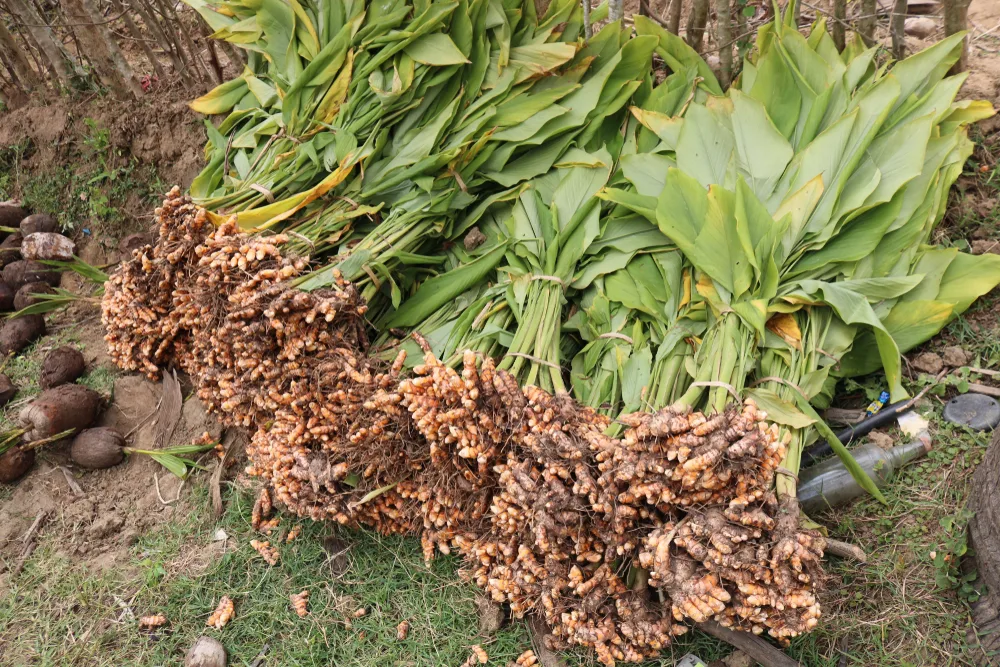
Turmeric, being a tropical plant, likes both the heat and the rain. Or rather, warm and humid conditions. Yet, it doesn’t like full sun when the temperatures are soaring about 90 °F every day. In fact, turmeric can even tolerate partial shade.
One thing that turmeric cannot handle, is frost. This makes it more ideal for those who are gardening in mild to warm climates.
So, what is a curious gardener with colder winters and the intent to grow turmeric to do?
Well, turmeric can be grown in large pots, provided that you can accommodate them in an indoor space when those unreliably cold temperatures come along.
It is one thing to grow and tend to an exotic plant.
But can you truly harvest anything after all the hard work that goes into caring for a non-native plant?
People ask this all the time.
In online forums, and in their own heads, wondering if it is really worth all the trouble to source, plant, tend and eventually harvest something that is as good as store-bought – if not better.
As for growing turmeric in a pot, while your harvests may be small, they will be intensely flavorful. After all, a little bit goes a long way. Just like with saffron, where you use just a few tiny threads of the crocus flower to make the meal mouthwateringly delicious.
Did you know that ginger can also be grown in pots indoors or in your very own backyard?
What is turmeric?
Turmeric (Curcuma longa) is an herbaceous perennial plant that also happens to be a rhizome. A rhizome being a creeping root that stores an abundance of starches and proteins necessary for its survival underground.
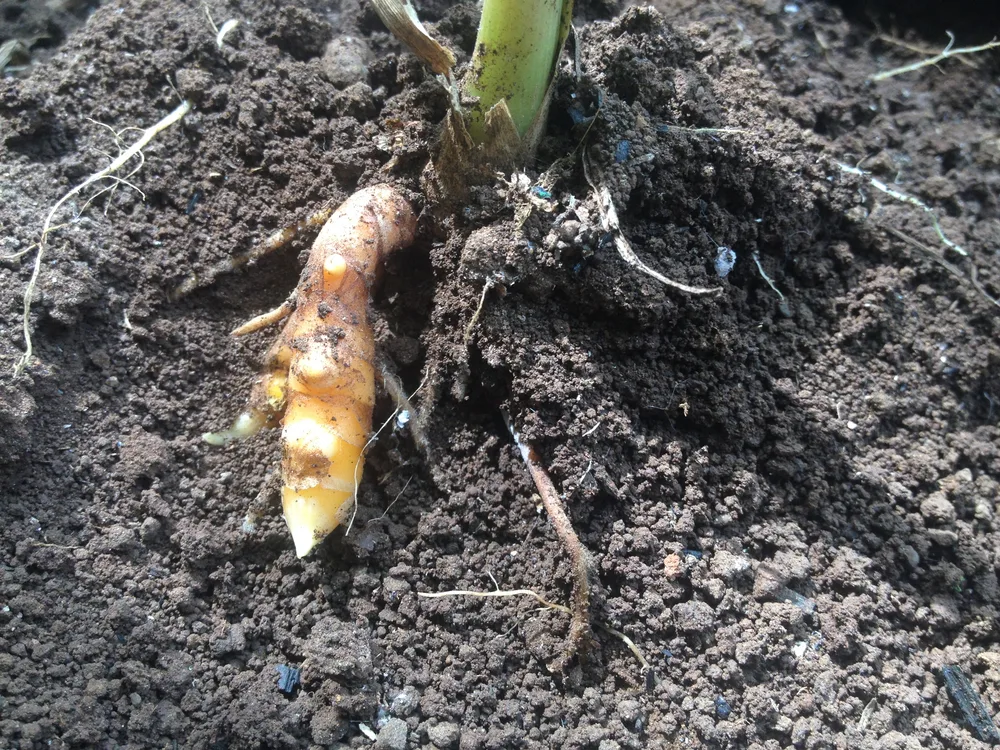
Turmeric belongs to the same plant family as ginger – Zingiberaceae – another fantastic rhizome with roots in Southern Asia.
Most people would only be able to recognize turmeric by its powdered appearance only.
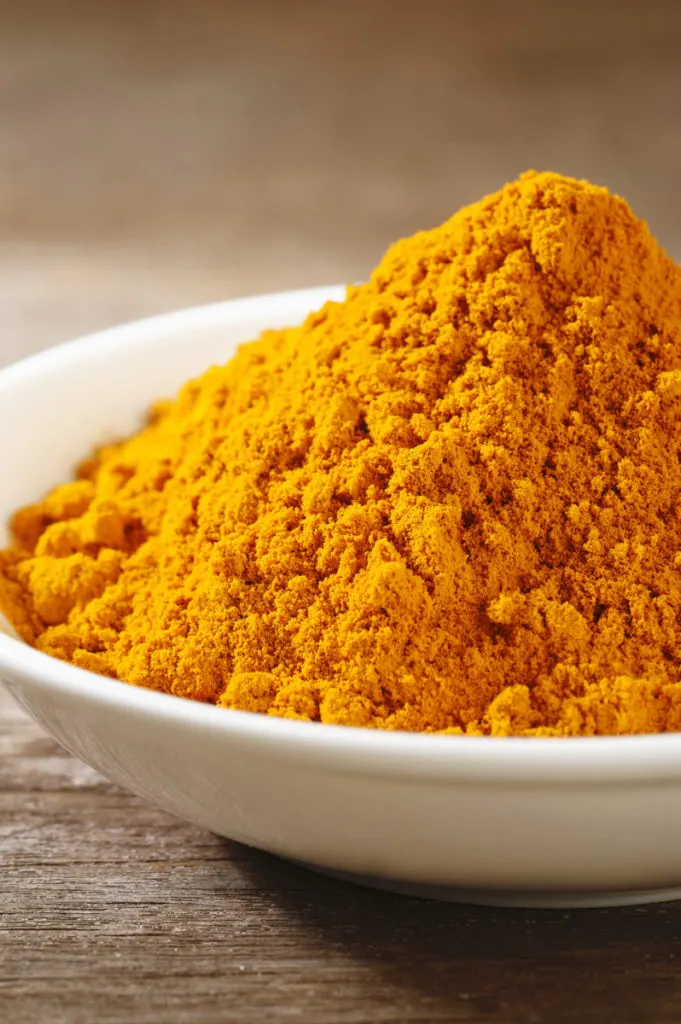
If and when you have the chance to grow it yourself, you will find out firsthand what the turmeric tubers look like. As well as having the chance to admire the 3 ft. green hosta-like leaves which spring up from the ground.
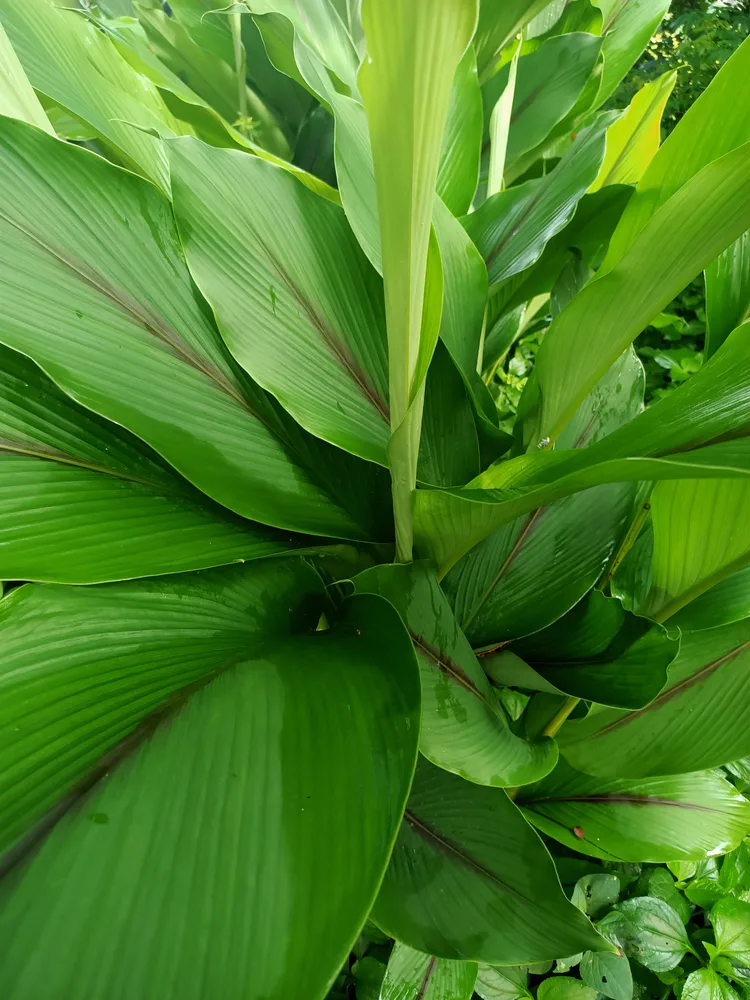
Benefits of using turmeric
Turmeric has reached a certain “superfood” status in recent years.
Now, I personally don’t follow such food labels, but I do use turmeric in cooking often. A little sprinkle on my morning eggs, a generous shake into a heartwarming stew, or in my mug of cinnamon or ginger tea. It can also be mixed into willow bark tea if you feel an oncoming headache.
As a pain reliever, turmeric works well in some cases, not so well in others. Which can only lead to my non-medical opinion that within the world of turmeric there are many variables. Combine that with the fact that we often react differently to certain foods and what works for some, will not necessarily work for all.
That being said, here are a few more good reasons why you should be consuming turmeric on a need-to-eat basis:
- turmeric has anti-inflammatory effects
- it may prevent Alzheimer’s disease as well as cancer, due to its generous antioxidants
- turmeric as a pain reliever eases arthritis symptoms
- it lowers cholesterol
- and it can improve your immune system – you can even add it to your fire cider!
Curcumin is the active ingredient in the turmeric rhizome which not only gives it the yellow color, but also what makes it so beneficial for the entire body.
The caveat, here, is that while powdered turmeric is what you will get from your backyard harvest, it is not nearly as powerful as taking a curcumin supplement. The curcumin content of turmeric is about 3% by weight, which is very little, all things considered.
In essence, if you are looking to relieve pain, it is not as simple as sprinkling turmeric on your dinner.
To read a more in-depth account of the benefits of turmeric and curcumin, click here.
Why grow turmeric?
If the benefits of consuming turmeric are not enough to convince you, why not grow turmeric for the sake of having some natural remedies on stand-by in your backyard. For you never know when you will need them.
It is one thing to make a plantain tincture, a healing comfrey-infused oil, an infused herbal spring vinegar or a nasturtium leaf vinegar for natural healing at home, though these are harder to think of as food.
Turmeric is not only food, it is a fantastic source of antioxidants as well as color. Sometimes adding a pop of intense color to your food is enough to lift your spirits and allow you to move on happily with your day.
When you grow turmeric at home, you also have the added benefit of eating the tubers in raw, fresh form. The tubers can be grated, ground into a paste or chopped.
If you use too much in a dish, it tends towards the bitter side. Newcomers to using fresh turmeric should start with less, then add more, to taste.
Where to find fresh turmeric for eating?
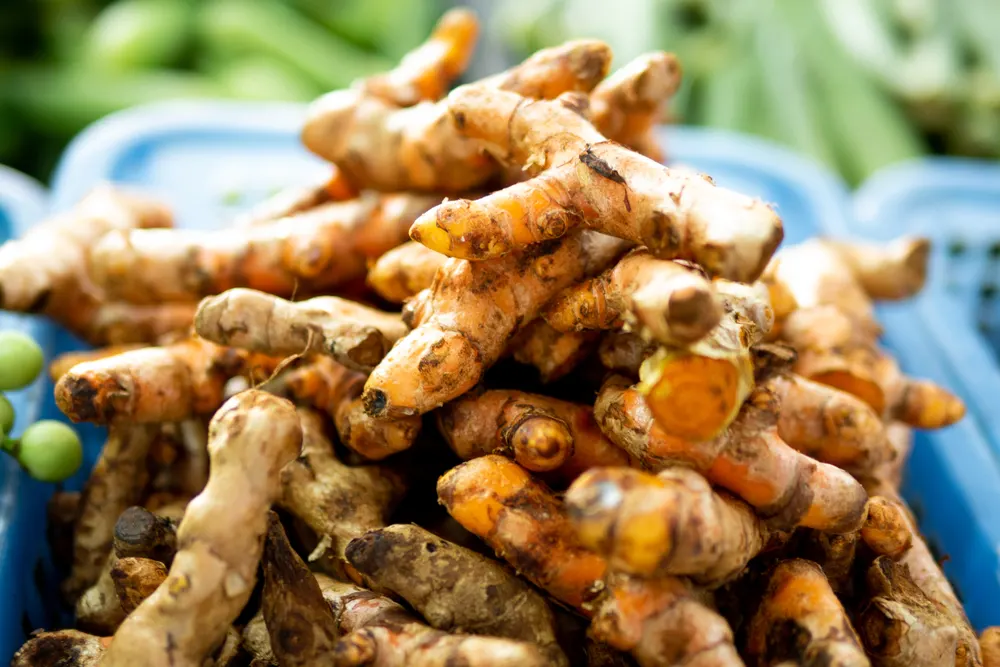
If you truly want to experience the flavor of turmeric, it is suggested to eat it fresh. In this way, you can also decide whether or not it is worth the work/struggle/joy of tending to it for several months before harvest.
You can usually find raw turmeric rhizomes at specialist grocery stores, including Indian grocers. Other times at natural/whole food stores or Asian markets. But be prepared to pay a price! This depends on your location of course, though when the nearest source is more than a 4-hour drive away (8 hours round trip!), it makes perfect sense to try your hand of growing it at home. Particularly if you wish to bring a turmeric root, or two, into your diet. Otherwise, organic powdered turmeric is the way to go.
Did you know you can eat turmeric leaves?
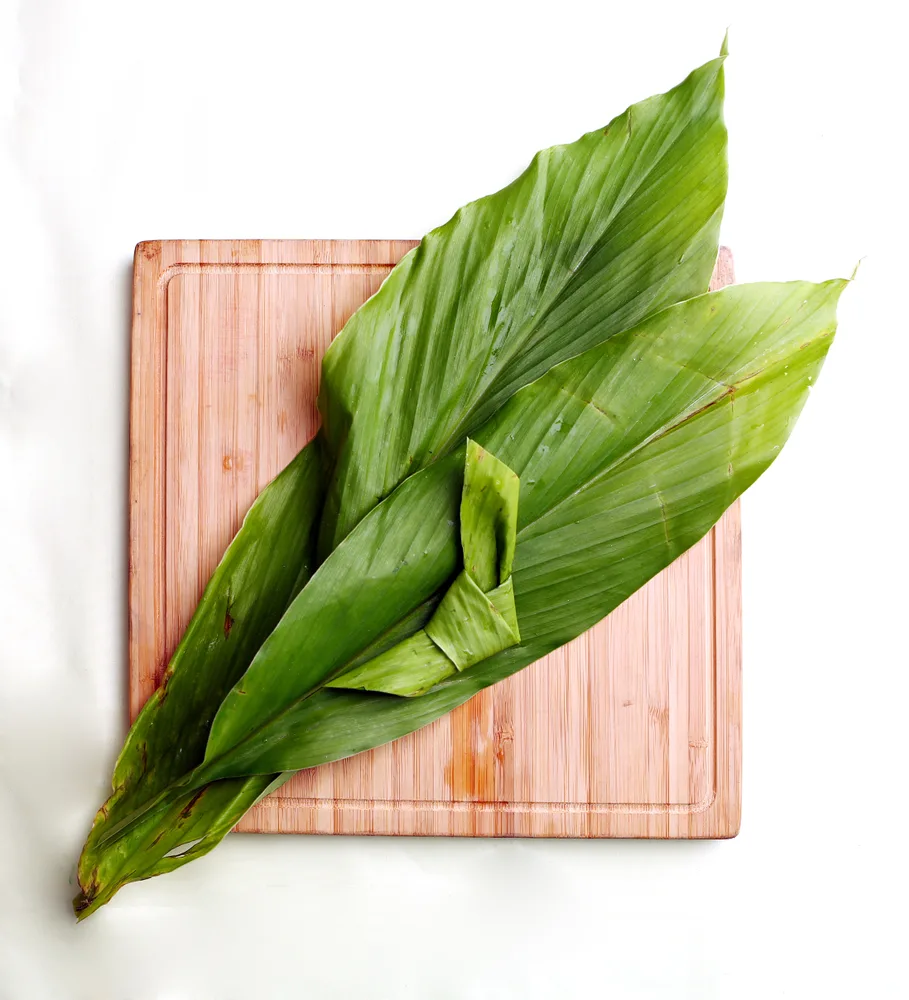
An unexpected side benefit of growing your own turmeric, is that you can also eat the leaves!
This is something that definitely won’t happen when you are buying fresh turmeric from the store. Because just like other uncommon greens to eat, such as beet and carrot tops, they will wilt long before they are consumed.
The leaves, an understatement compared to the rhizomes, are also very special in cooking.
Turmeric leaves can be used whole (like banana leaves) for wrapping fish and other items placed over the grill. They can also be dried and ground into a green powder for flavoring other Indian-inspired dishes.
Once your homegrown turmeric starts producing, give it a try. Just remember to harvest one or two leaves from each plant, so as not to stress it. Unless you are harvesting your rhizomes all at once, in which case you will have all the leaves you would ever care to eat from.
Sourcing turmeric for planting
Now, there is one remaining question. Where can you find turmeric roots for planting?
If you are fortunate enough to have a source of organic turmeric rhizomes within reasonable distance, then you are actually in luck!
Because store-bought organic turmeric rhizomes can be successfully planted and harvested. The focus here being organic.
If they are not certified organic, you are free to take your chances, though many times it will only lead to frustration. Non-organic produce may be treated with chemicals to inhibit sprouting. You just never know what you are going to get.
You can also source your turmeric rhizomes and plants online.
Once your turmeric gets growing…
You will be able to replant your own turmeric rhizomes – just as you would Jerusalem artichokes. From then on, you will have a free source of propagation material.
Where to grow turmeric
Turmeric can be grown outside in zones 8 and above.
Click here to find your planting zone.
If you fall below that mark – and most of us do – all hope is not lost.
Turmeric can easily be grown in pots, no matter where you live.
Keep in mind that your plants will need access to full sun ranging to partial shade. The soil it is potted in should be rich in organic matter, so feel free to add compost liberally.
While turmeric loves both heat and moisture, the soil must be well-draining. Otherwise, the roots may rot – and you will have to start over from the beginning.
Soil pH can range from slightly acidic to slightly alkaline, leaving you with lots of room to experiment.
You don’t need to grow turmeric in a greenhouse per se, though it wouldn’t hurt the plant one bit. You can also leave it out on the balcony, or the patio for a tropical look, bringing it in when temperatures dip below 50 °F at night.
Planting turmeric – choosing a pot
Choose a pot that is at least 12″ deep, with the same width (or larger). The tubers will need plenty of space to grow freely beneath the soil surface.
Plant them as you would potatoes, or ginger, about 2-3″ underneath the soil surface. 2 rhizomes per pot should be sufficient.
The planting process of turmeric rhizomes:
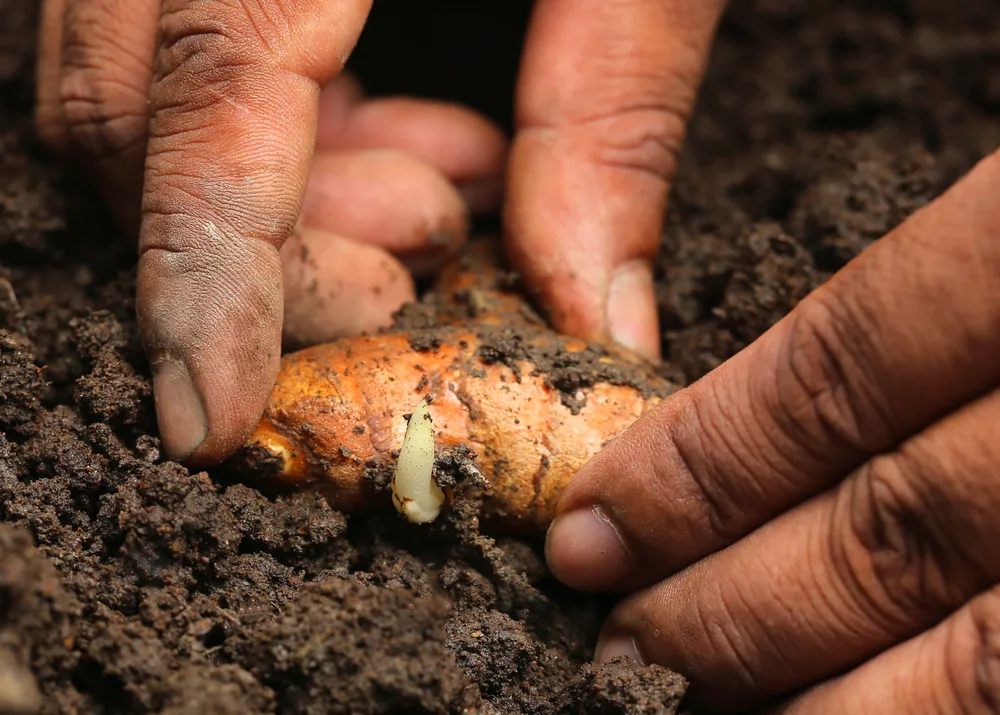
- break, or cut, larger turmeric rhizomes into smaller pieces, leaving a minimum of two buds on each segment
- fill your pot with well-draining soil
- plant your turmeric rhizomes 2-3″ below the soil with buds facing upwards – not downwards!
- water the soil deeply, keeping it moist throughout the season, being sure not to waterlog the roots
And then, as with most gardening related tasks, comes the waiting.
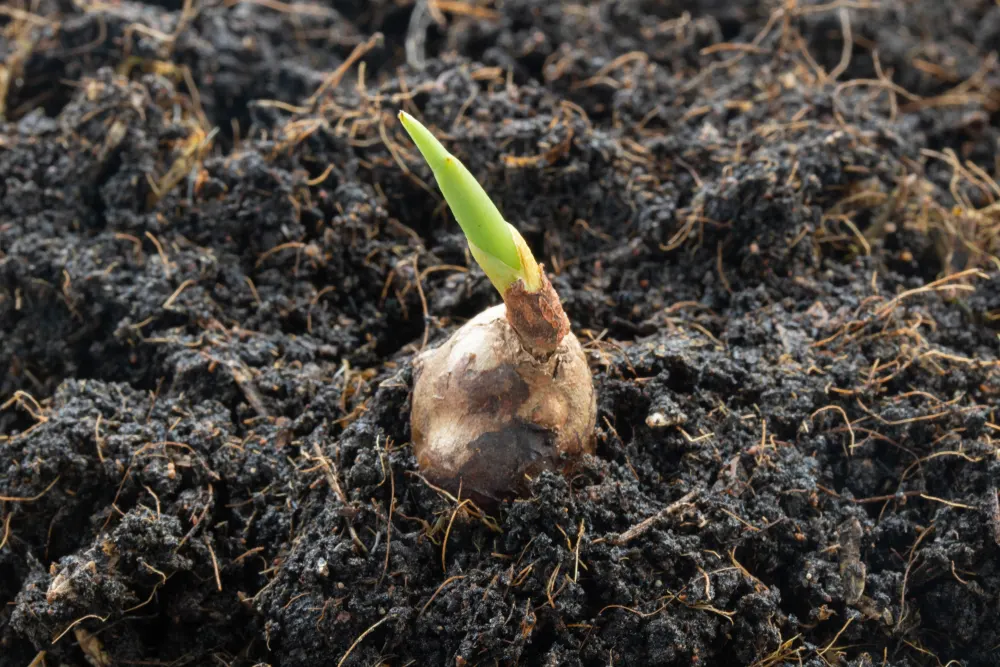
Perhaps even more waiting than you would expect for a few tubers to emerge.
If you are able to plant directly outdoors as soon as March, you may not even see the first emergence of leaves until July!
So, don’t forget where you have planted them.
Even in pots, they will take their time. Just be sure that the soil is warmer than 55 °F before planting. Then begin the waiting process, for not all plants shoot up so quickly as sunflowers and sunchokes.
How long does it take to grow turmeric?
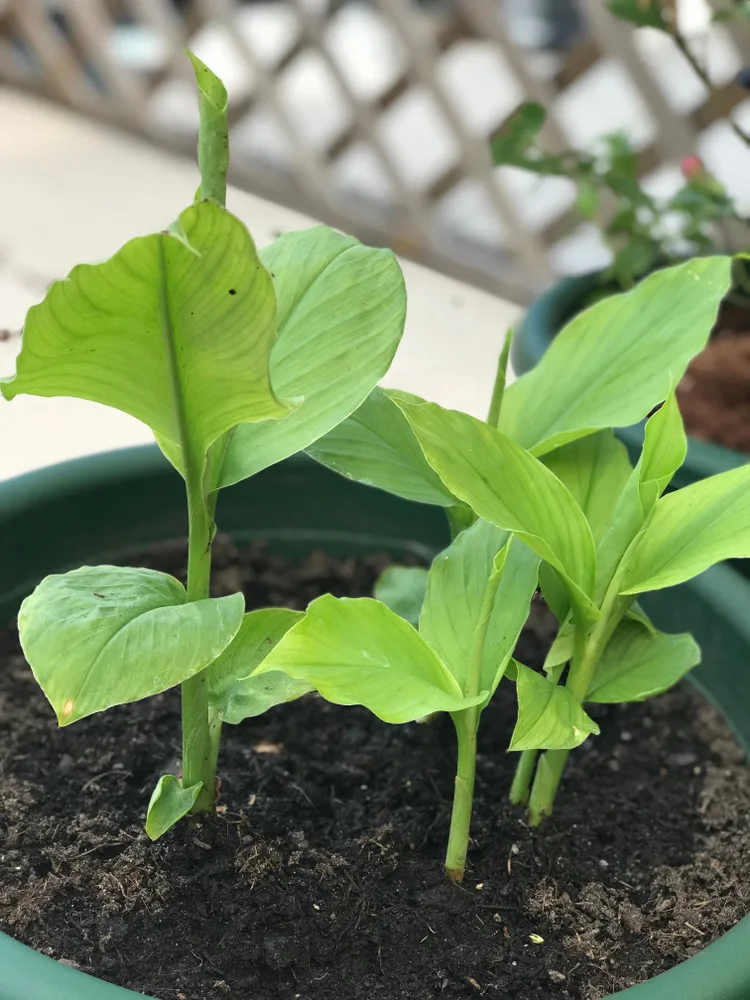
Turmeric will mature in 200 to 360 days. Yes, even up to a year.
Trust me, it is one of those harvests that is well worth the wait.
In the meantime, your turmeric will grow to great heights of 3-4′, expanding 3′ in width. Make sure to leave plenty of room when growing it in the garden. And be sure to plant in a large enough pot, so as not to restrict growth.
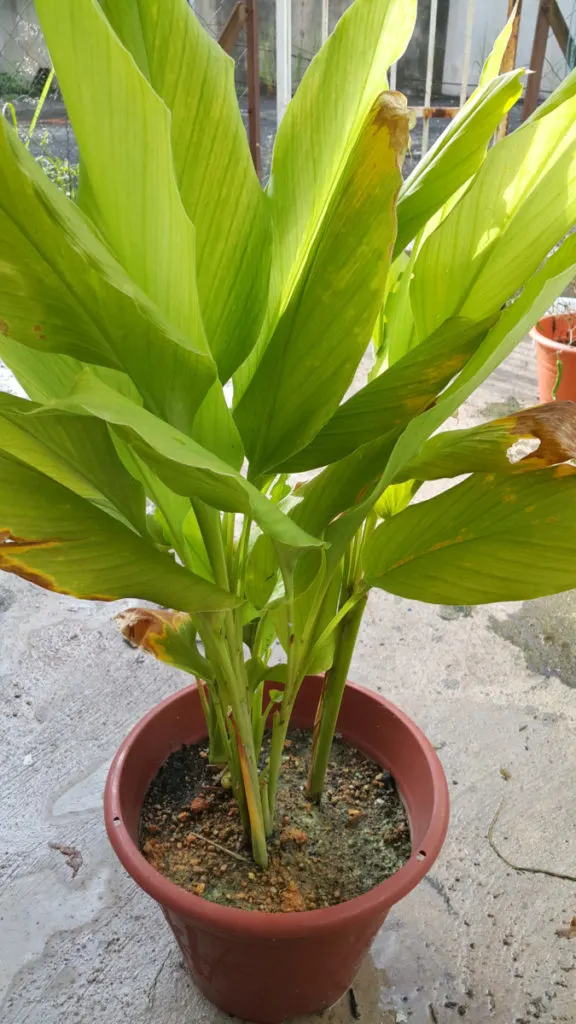
Growing turmeric in a warmer climate
The ideal temperature range for growing turmeric is 68-95 °F. If you have that climate, your turmeric is as good as gold. But, if the temperature drops below 50 °F, the plant may suffer.
The good news is that if you are gardening in zones 8 and above, you can skip the pot and plant your turmeric rhizomes straight in the ground.
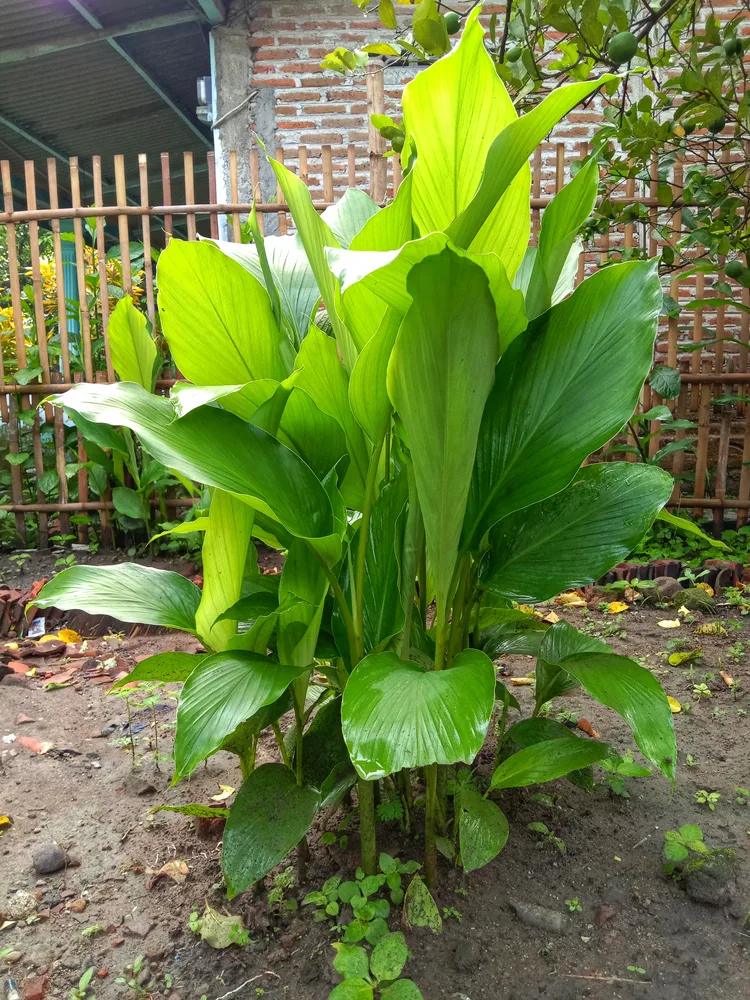
Just be sure that the soil is rich and well-draining. You might want to incorporate compost into the soil before planting, then cover with a thin layer of mulch to retain enough moisture.
Your turmeric will need to be watered periodically throughout the growing season. Keep it wet, but not too wet.
Overwintering turmeric in the ground
In tropical climates, turmeric can be planted year round. But in planting zones 8-11, it is still best to plant at the beginning of summer as soon as soil temperatures have warmed up.
As the growing season progresses and turns into winter, in order to overwinter your turmeric rhizomes in the ground, you will have to do two things:
- reduce watering once the leaves begin to turn yellow and wilt
- finally, cut the stalks all the way back to the ground
To this, you can also add a thick insulating mulch layer of 6″ to help the rhizomes overwinter.
If you are the cautious type, you can always harvest the tubers by digging them up, drying them out and gently removing excess soil. Store them in a cool, dry place until they can be replanted next growing season.
Caring for your growing turmeric
Growing turmeric is almost too easy.
Once planted, you won’t have a lot to do, other than sit back and watch your turmeric grow.
If leaves become dry, you can remove them with a pair of pruners. Other than that, you shouldn’t need to clip back any leaves. Unless you are eating the occasional one.
Turmeric is also very hardy when it comes to dealing with pests and diseases. The biggest threat being overwatering, which can cause rhizome rot. From time to time, your turmeric may face the challenges of spider mites and leaf spot.
If slugs or snails are approaching your turmeric leaves in hopes of a feast, your first line of defense should be diatomaceous earth, or dried eggshells.
Let it grow and get ready to harvest the freshest turmeric rhizomes you have ever eaten! You’ll find out more on how to cook with them as you scroll further down, with some scrumptious recipe ideas to give you turmeric-inspiration.
Harvesting turmeric
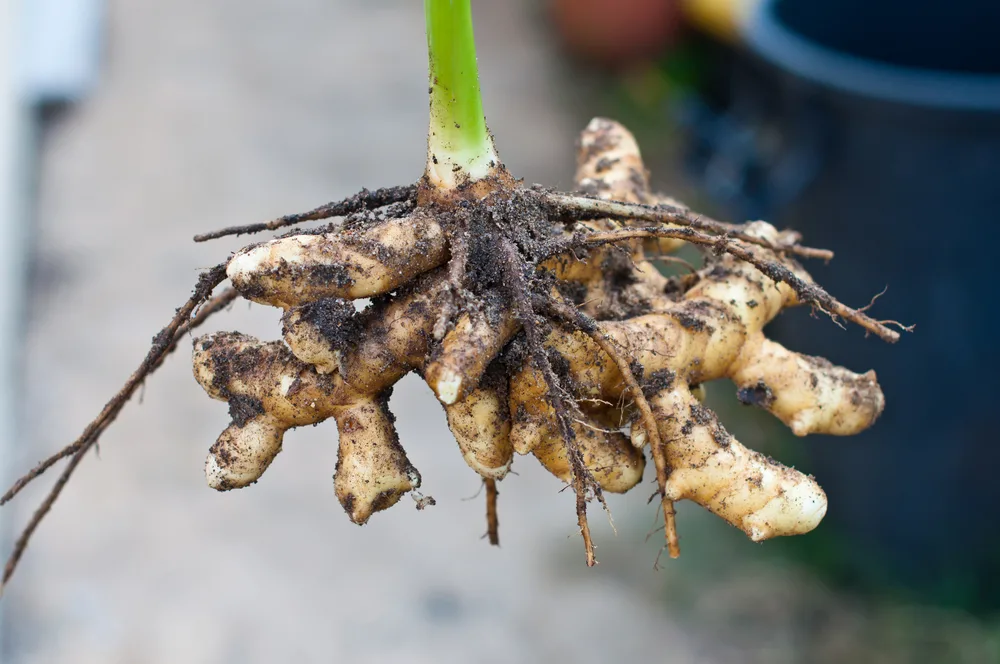
Turmeric rhizomes are to be harvested in fall.
You know it is almost time when the foliage begins to turn yellow and die back. As you dig them up, be sure to dig in a wide enough circle not to cut into the rhizomes. Gently pull on the remaining stems to ease them out of the ground.
If you have grown the turmeric rhizomes in a pot, harvesting is even easier. Set the pot on its side, preferably outside, and pull on the remaining greens. Your tubers should come out in one big bundle.
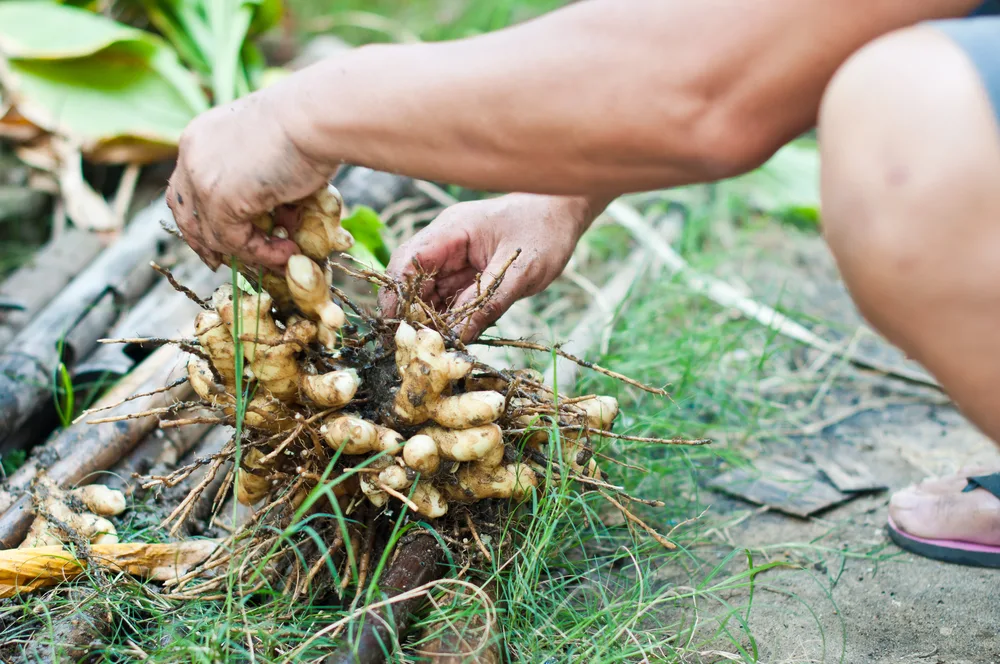
Once the rhizomes are out of the soil, let the soil on them dry. Then gently brush off the excess soil, breaking the harvest apart only as needed.
You could also give them a quick rinse under running water, being sure to dry them out sufficiently afterwards. They must be cured before storing for winter.
For now, you get to enjoy your homegrown turmeric fresh, fermented or dried.
How long can you make your turmeric harvest last?
Fresh turmeric will last in the fridge for just a couple of weeks. Three weeks, if it is unpeeled.
Or up to 6 months in the freezer. When you grow your own turmeric organically, it is easy enough to just pop one out of the freezer and grate it fresh, skin and all. No need to bother with peeling – but if you still decide to do so, it is best done with a spoon.
However, if you want to enjoy your turmeric harvest for an extended period of time, drying it will be your best bet for having that delicious and nutritious yellow spice throughout the year.
Drying and grinding turmeric
You don’t need anything fancy to get the job done right. People have been grinding and powdering turmeric for thousands of years. Yes, it takes some muscle to get it done, but as a gardener, you’ve probably done at least a thousand more difficult things.
If you are appliance-oriented, you can still use that equipment too. Although it takes away, just a little bit, from the ancient thrill of lovingly preparing food by hand.
Related reading: How To Make Powdered Ginger – And A Delicious Drink Recipe To Put It In
Let’s go quickly through the steps, then link to a detailed tutorial of how to process your own turmeric rhizomes.
- Wash the turmeric rhizomes, peel if desired.
- To boil, or not to boil, the rhizomes? Some recipes call for this, others don’t. It is your call.
- Slice the rhizomes into very thin pieces. Use caution as turmeric tends to stain everything yellow! This includes your cutting board, as well as your hands, and apron too.
- Air dry the slices. Alternatively, you can use a dehydrator or the oven.
- Grind your dry turmeric slices with a manual or electric coffee grinder, or food processor. A mortar and pestle has been working wonders for generations too! Sift through a strainer for the finest powder.
- Store your turmeric powder in a (reused) glass jar with a tight fitting lid.
If you’ve gone through the steps and made sure that the turmeric is properly dried, you can then store your homemade turmeric powder for 2 to 3 years.
The Easiest Way to Dry and Process Turmeric Root to Make Turmeric Powder
Using turmeric in cooking
Now, that you’ve harvested your homegrown turmeric (or snagged a golden delicious bounty from the market), take every chance you get to try something new. For turmeric, whether raw or powdered, is a versatile, perhaps even essential, kitchen spice.
Try one, try them all, just don’t do it all in the same day. Too much of a good thing is still too much. Space out your turmeric trials, learn what tastes good (to you) and just have fun with it. Even if your fingers get a little stained from time to time.
The following recipes will use turmeric either in raw or powdered form.
Turmeric juice

If you are seeking to boost your immunity, or reach higher levels of enlightenment, fresh turmeric can help get you there. Jamu juice, a traditional Indonesian herbal drink, contains fresh turmeric, fresh ginger, a pinch of black pepper, honey and coconut water. Serve it warm or cold for a downright refreshing drink. Golden root juice uses perhaps more the kind of veggies that you are likely to have growing in your garden: carrots, beets and apple.
Jamu Juice (Turmeric Ginger Drink) @ Downshiftology
Turmeric Golden Root Juice @ Feasting at Home
Golden milk
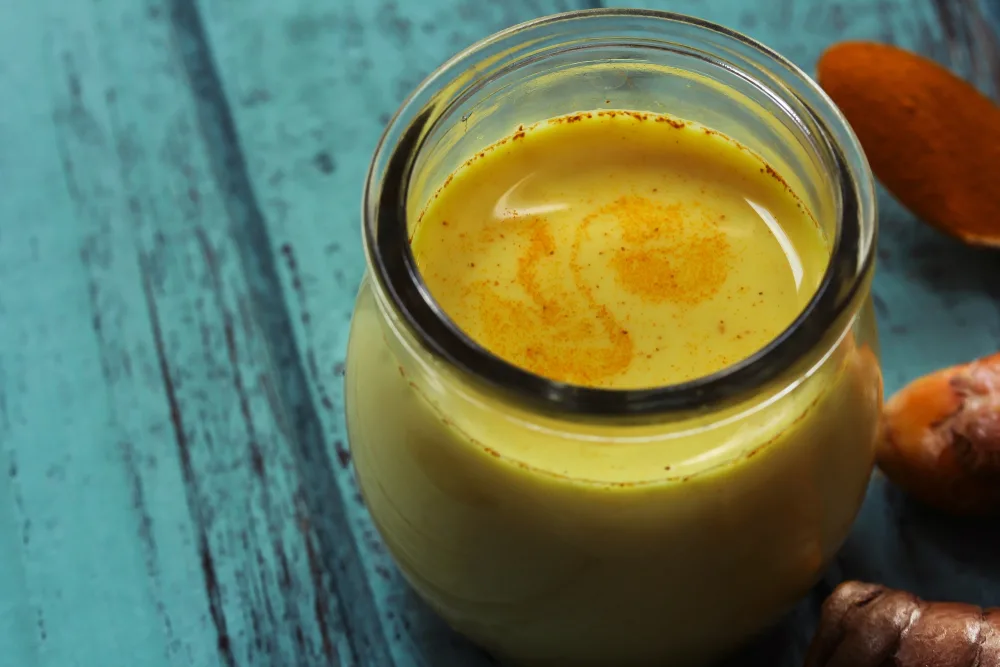
One of the first turmeric drinks you are most likely to encounter is golden milk. It is used in Ayurvedic medicine for those with joint pain, fatigue, breathing and digestive issues.
5-Minute Golden Milk @ Minimalist Baker
Turmeric latte

I know it is hard to give up coffee, but give this caffeine-free turmeric latte a chance. At least every once in a while.
Turmeric Latte @ Simple Vegan Blog
Turmeric smoothie
You would expect a turmeric smoothie to be yellow, right? Not this one.
Berry Turmeric Smoothie @ Well Plated
But this one with frozen pineapple and frozen mango is:
Anti-Inflammatory Turmeric Smoothie @ Happy Healthy Mama
Turmeric added to your morning tea
One of my favorite ways to get a burst of turmeric in my diet is in my herbal tea.
Turmeric combined with willow bark, makes for a bitter healing morning tonic. It also tastes great with ginger or lemon peel tea (made from organic lemons, of course!).
Honey-turmeric chicken
Moving outside the realm of drinks and into the world of eats, you will find that chicken pairs nicely – and often – with turmeric. It happens to be an almost magical seasoning when combined with garlic, honey and cayenne pepper.
Honey Turmeric Chicken @ Rasa Malaysia
Cauliflower chowder
If you are in search of a winter warming soup, full of cauliflower, chicken stock, coconut milk and turmeric, topped with crumbly bacon bits, this is the one for you:
Cauliflower Chowder @ Paleo Leap
Turmeric coconut curry

If easy homemade meals are your go-to sort of thing, and you are watching what you eat, that leaves out just about everything tasty. At least that is what it feels like when you are hungry.
Here is the answer to correct that:
Coconut Curry Turmeric Chicken (Whole30, Anti Inflammatory) @ 40 Aprons
Chickpea and butternut squash curry
Healthy and full of incredible flavor don’t always describe the same dish.
But they can, if you put your heart into cooking, and choose the right ingredients.
Spicy Chickpea and Butternut Squash Curry with Coconut Milk and Turmeric @ Eat Well Enjoy Life
Other uses for turmeric
Besides knowing how to eat and drink your turmeric, notice that it is useful for a handful of other things.
Whitening teeth
You would probably never guess by the way it stains your hands and countertops bright yellow, that turmeric can, in fact, whiten your teeth.
How To Whiten Teeth Naturally With Turmeric @ Mommypotamous
Turmeric in soap
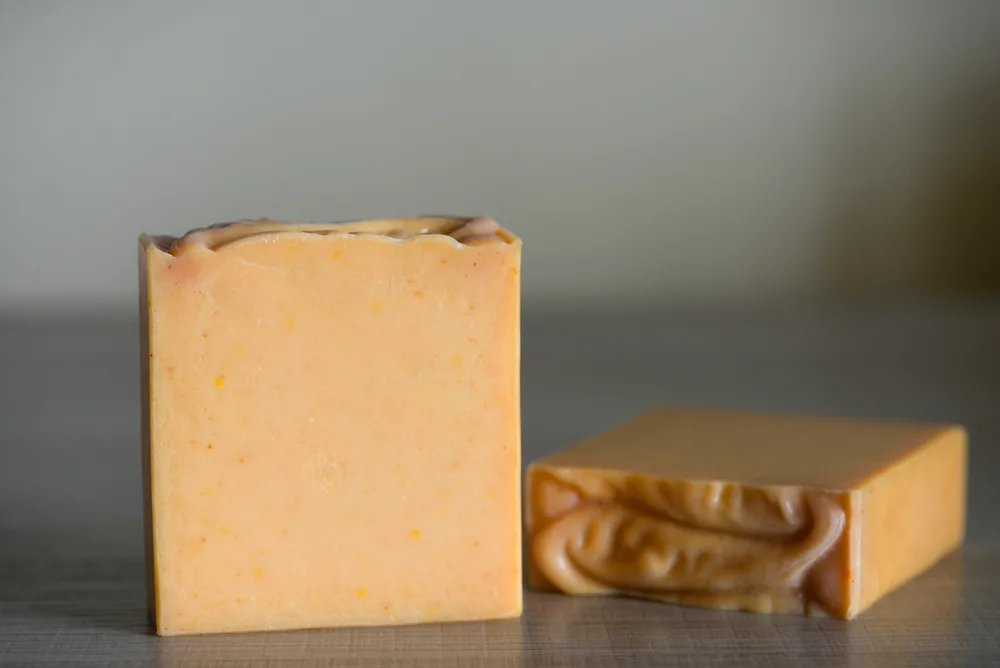
When turmeric is added to soap, the vibrant colors will inevitably be toned down, but that doesn’t stop it from nourishing your skin.
Natural Turmeric Soap Recipe (three different shades) @ Lovely Greens
Turmeric as a natural fabric dye
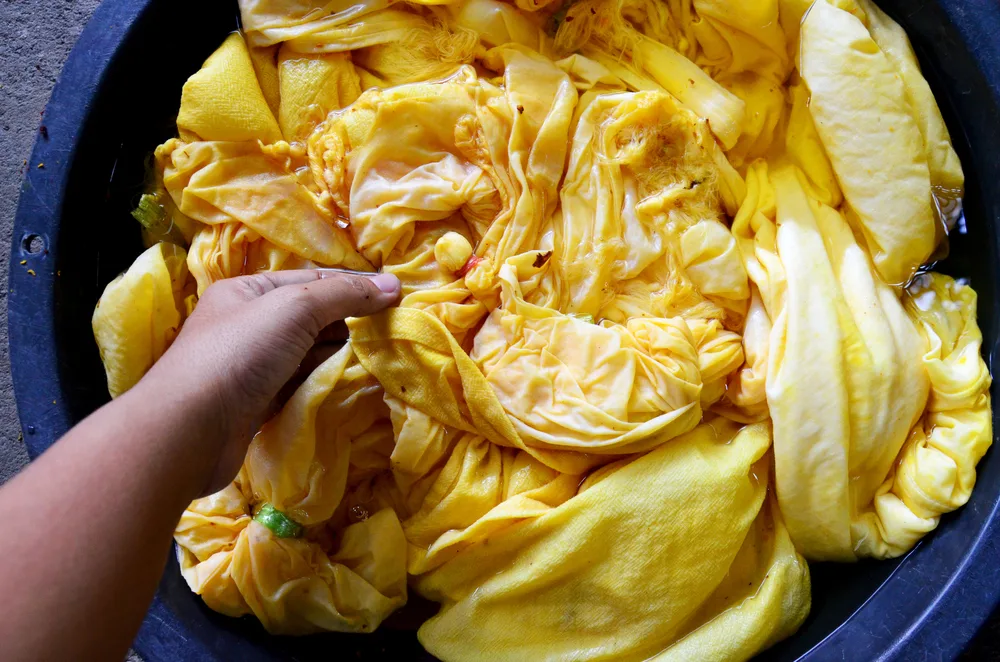
When used as a dye on natural fabrics such as cotton, linen, silk and wool, it will leave a warm yellow on your clothing. When this is done intentionally (not a spill), this is a wondrous thing.
DIY Turmeric Dyed Reusable Produce Bags (Zero Waste Craft) @ Compost and Cava
Not only that, turmeric can also be used to dye Easter eggs, color homemade play dough and it can be stirred into a cake.
Okay, that is essentially food, yet it has to be mentioned. You are welcome to eat more than one slice.
Lemony Turmeric Tea Cake @ NYTimes Cooking
Sfouf (Turmeric Cake) @ Feel Good Foodie
For the optimal health benefits of consuming turmeric, remember to add a dash or pinch of black pepper to your turmeric-y dishes.
This increases the bio-availability of curcumin in turmeric, giving you more of that pain-free life you desire. You can get even more of the curcurmin benefits by adding healthy fats to your food, such as coconut oil, coconut milk and olive oil.
Whether you are interested in growing turmeric for all the natural health benefits, or just to try something new, know that success is just around the corner – at least a year from now.
All good things are worth the wait.
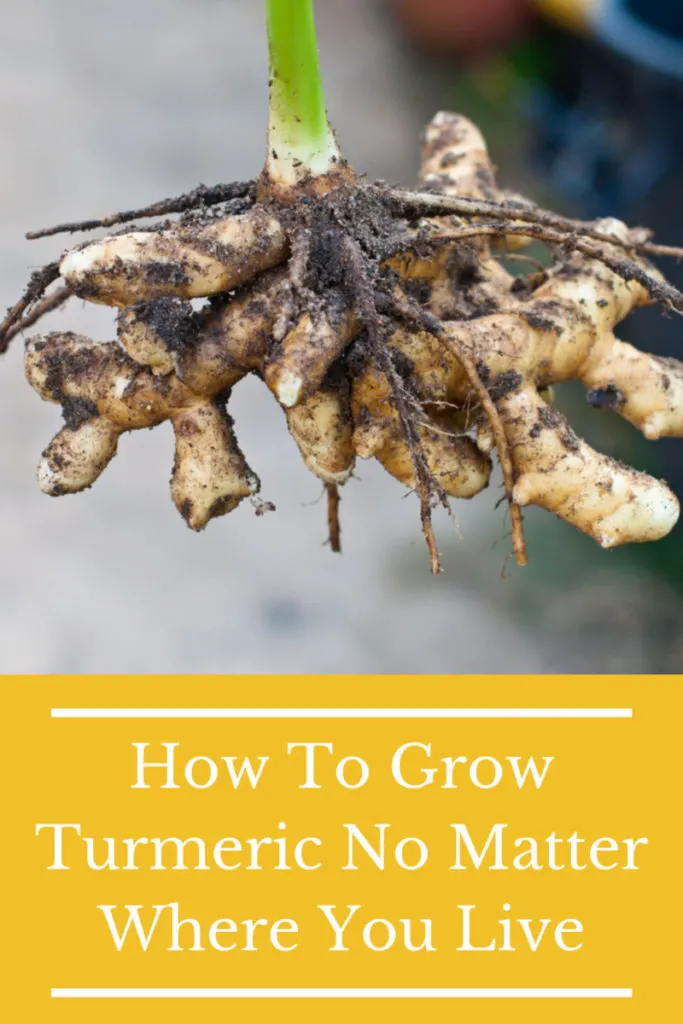

Get the famous Rural Sprout newsletter delivered to your inbox.
Including Sunday ramblings from our editor, Tracey, as well as “What’s Up Wednesday” our roundup of what’s in season and new article updates and alerts.


